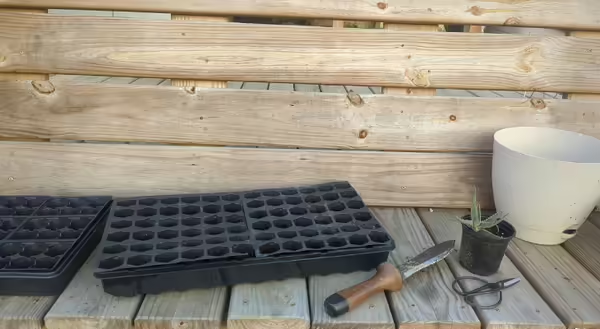
Here in Olney, we have been on the same weather roller coaster as the rest of the state. At my house, we received around 2 1/2” of snow along with sleet and drifting on February 16. In a week we have gone from 70-degree days to 19-degree lows and now back to 53 degrees.
Like everyone else, I am itching to get my transplants started for the spring growing season and my family is excited for me to move my collection of plants outside. My inventory of seed starting supplies includes all the treasure that I saved from last year including my 72 cell trays that I never cleaned and a bag of paper towel tubes.
Seed starting can be an expensive and sometimes wasteful process that can leave us looking for ways to save time and money. There are several options for cutting costs and reducing waste when it comes to seed starting. These options can include reusing plastic trays and pots from the previous year, soil blocking, and making your seed containers.
Reusing Containers
The most common way I have seen growers save a little money is by reusing trays from the previous year. The most important thing to remember is to thoroughly clean and then disinfect the trays. Cleaning and sanitizing are equally crucial to successfully reusing pots and trays, and it is important to know the difference. You can use water or compressed air to remove visible dirt and plant debris or soak them in soapy water and rinse to remove any stuck-on materials. Pots can’t be properly sanitized unless they are thoroughly cleaned. There are several commercially available sanitizers for greenhouse use, but you can also use a 10% bleach solution for at least 10 minutes and then rinse. A spray of undiluted 70% rubbing alcohol can also be used to disinfect pots and tools. If you had a disease issue in your transplants, it would be best to discard the affected trays to be on the safe side.
Soil Blocking
Blocking can save a lot of plastic waste and potentially save money… maybe? Soil blocking can be a fun and creative way to make sturdy transplants with good root systems. The main costs of soil blocking will be the block shaper, soil mix, and trays to hold the blocks. The key to good blocks is getting the ratio of your potting mix correct so the blocks don’t fall apart. There are several commercially available blocking mixes, and the internet is full of recipes. It takes some experimenting to get the process right the first time, and this may be a drawback for large-scale transplant production.
DIY Pots
If you are just starting a few transplants, you might be able to make your pots using paper, cardboard, or egg cartons. The main drawback to making paper or cardboard pots is that they will break down as you water them and might be difficult to transport.
Below are several resources for sanitizing, soil blocking, and DIY pots.
Containers for Starting Seeds by Iowa State Extension
Cleaning & Sanitizing Pots by Iowa State Extension
Greenhouse Sanitation by Utah State Extension
Sanitation for Disease and Pest Management by Purdue Extension
Making Soil Blocks by Penn State Extension
Impacts of Soil Blocking on Yield by MSU Extension